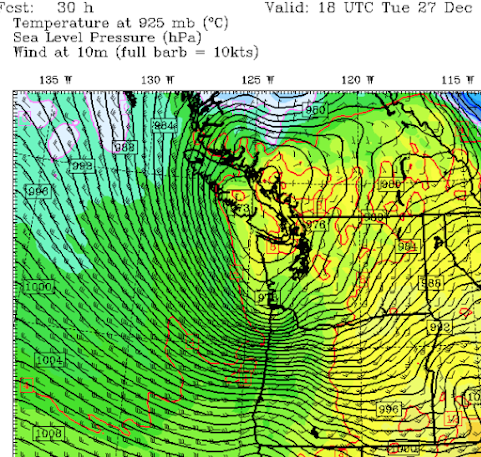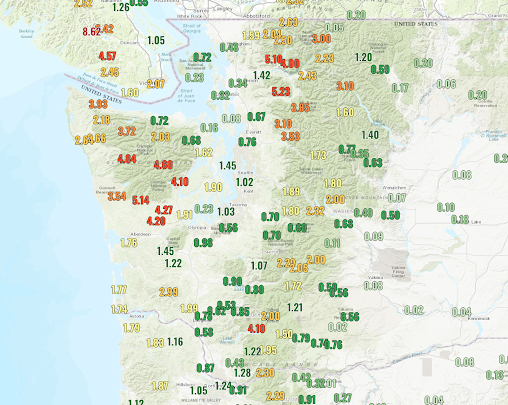There has been a lot of discussion in the media and elsewhere about the recent flooding in Seattle's South Park neighborhood, and others have noted high water levels on the Sound shoreline, including Alki Beach and Tacoma (see some pictures below).
The origin of the flooding is described in this blog.
To give away the punchline, the flooding was the result of an unusual astronomical setup producing King Tides, extreme low pressure from a powerful storm, moderate rainfall, and a human-caused vulnerability in South Park that should have been dealt with years ago.
Although some are making unfounded claims about climate change, global warming played very little role in the flooding event, something I will prove to you below.
The South Park flooding, courtesy of the SDOT Blog
Coastal flooding in Tacoma. Picture courtesy of Jenni Wynkoop
King Tides
The key aspect of this event was the King Tide, very high high-tide levels resulting from an unusual astronomical alignment of the Earth, Moon, and Sun.
As many of you know, tides are the result of the gravitational attraction of the moon and sun on the oceans and large bodies of water. When the moon is closer to the Earth (in perigee) tides are large. When the sun and moon are aligned (as in full or new moon) the tides are higher. And when the Earth is closest to the sun (which occurs in early winter!!) tides are higher.
This week all of these factors were near optimal, producing a high-amplitude King Tide, with NOAA predicting King Tides reaching 12.9 ft above sea level on December 26 and 27.
Below are the predicted (blue) and observed (red) water levels for December 25-27 in Seattle from NOAA. The forecasts were excellent on December 25th but greatl underpredicted the actual maximum water level (about 15 ft!) on Tuesday, December 27.
But why such a large error? Global warming did not suddenly show up for a few days. It has to do with the low pressure associated with the incoming storm on Tuesday.
Low Pressure Produces High Water LevelsIt turns out that a regional low-pressure center caused localized water level increases, something called the inverse barometer effect (see figure).
Image Courtesy of Swellnet
The sea level pressure above western Washington was EXTRAORDINARILY low on Tuesday--the lowest of 2022. Want proof? Here are the pressures at SeaTac Airport for the period.
Here is a close-up view of the pressure this week at SeaTac. Mama mia! Down to 978 hPa/mb on the 27th. Folks this is very low pressure for the interior of western Washington. Water levels would be much higher as a result.,
So we start with an unusual astronomical setup, with high tides we only see a few times a year. And then we get extreme low pressure that happens to occur on the King Tide day.But what about the rainfall?
The major low-pressure system/cyclone making landfall on Tuesday brought moderately heavy rain to the region, with 2-3 inches falling on the western slopes of the Cascades over December 26-27. 1-2 inches fell over the lowlands during the same period. Heavy but not exceptional.
This moderate rainfall drained into the Green/Duwamish River, which started out considerably BELOW NORMAL (see the Green's river level at Auburn below). The substantial rainfall resulted in water levels rising to normal levels on December 27th and about 2 feet above normal on December 27th. (note that hollow diamond symbols indicate normal levels)
So we had an unusual astronomical configuration, a storm with unusually low pressure, and moderate rain associated with the storm. The astronomical and pressure effects resulted in a high tide about 3 feet above normal in the Sound.
Sea Level Rise
How much might sea level rise, which is only partly due to a warming Earth, contribute to the high water?
Below is a plot of sea level in Seattle over the past 120 years. You will notice that sea level has gone up about 2.07 mm per year. That is 4 inches during the past 50 years. That certainly does not explain what happened earlier this week. A very small contribution.
An interesting point is that sea level rise is not accelerating during the past decades, something one would expect if global warming was the dominant cause. Also sea level rise has been going up for a long time...before mankind could have been the cause. In short, the contribution of global warming to regional sea level rise is highly uncertain and certainly small at this point in time (it will increase later in the century).
The Human Cause of the South Park Flooding
The South Park area has flooded repeatedly during the past century, which is not surprising: it is located on the historical flood plain of the Duwamish/Green River. The "river" next to South Park is a totally artificial human-constructed channel.
But the big problem is that during high tide the stormwater drainage pipe for the area CAN NOT DRAIN INTO THE RIVER. So appreciable rain brings flooding.
This is an essential flaw in the drainage engineering of the region and the City has known this for decades. Here is a quote from a City of Seattle website:
Today they are constructing a pump station to reduce the problem.
Disappointingly, the story in the Seattle Times on the flooding did not discuss the above engineering flaw at all. The initial version of the story missed the low-pressure contribution as well. And the SPU statement on the flooding tried to suggest that it was associated with climate change.
Poorly informing or misinforming the citizens of the city about environmental challenges is counterproductive to solving problems. Or in bringing "environmental justice" to residents of South Park.
















.gif)
.gif)
































